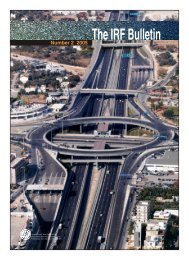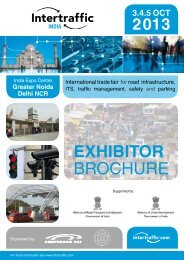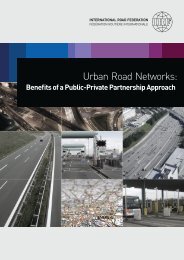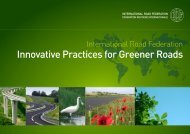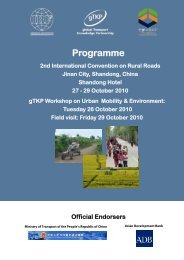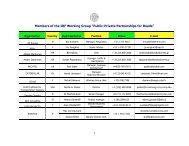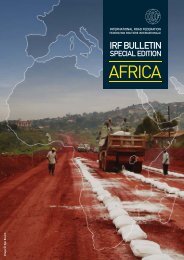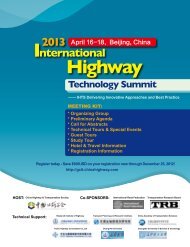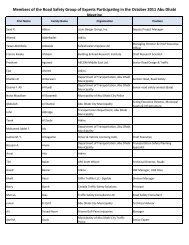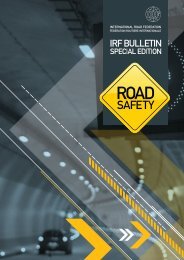TRANSPORT
TRANSPORT
TRANSPORT
- No tags were found...
You also want an ePaper? Increase the reach of your titles
YUMPU automatically turns print PDFs into web optimized ePapers that Google loves.
SOCIO-ECONOMIC BENEFITS<br />
of Roads. The programme is being part funded by the<br />
Swedish International Development Cooperation Agency<br />
(Sida) and has a target of bringing 75% of the road<br />
network (some 5,500 km) in the programme districts<br />
under routine maintenance after their improvement. The<br />
programme’s financial outlay is Kenyan Shillings (KES) 1.83<br />
billion (approximately US$ 24 million). Nyanza is a province<br />
situated in the far west of the country, on the shores of<br />
Lake Victoria. It is one of the poorest provinces in Kenya,<br />
with an elevated infant mortality rate and a high incidence<br />
of HIV/AIDS.<br />
ITT Ltd. has been acting as the Technical Assistance<br />
Consultants to the programme. The consultancy team is<br />
providing management support and technical advice to<br />
KeRRA to implement the programme. The road improvement<br />
and maintenance work is undertaken using employment<br />
intensive technology that engages local workers to carry<br />
out the majority of the work through local contracting<br />
companies. In order to ensure ongoing monitoring and<br />
evaluation of the programme, the Consultants fielded the<br />
authors as socio-economic experts to assess effects and<br />
impacts. The main points of the appraisal are summarised<br />
in this article.<br />
The Study<br />
A quasi-experimental study design was adopted which<br />
analysed the “before - after” (or longitudinal data) within<br />
a “with - without” format (cross sectional comparative<br />
framework) to estimate project effects against nine key<br />
indicators. The longitudinal comparison indicates the<br />
changes that have taken place between two different points<br />
in time (a 3-year period). The cross sectional analysis helps<br />
to simulate the counterfactual. This type of methodology is<br />
common in road improvement related development impact<br />
assessments.<br />
Overall Traffic<br />
The road development programme contributed to a<br />
significant increase in the volume of motorised traffic. The<br />
table below shows that motorised traffic increased almost<br />
fivefold. However, no significant volume changes were<br />
observed for the non-motorised modes or pedestrians.<br />
Although there was a reduction of almost 50% in Non-<br />
Motorised Traffic (NMT) on the control roads, this was<br />
not found to be significantly different after subjection to<br />
statistical t-tests (at the 95% confidence interval).<br />
Traffic Volume Changes<br />
Traffic Project Roads Control Roads<br />
Total 30% -15%<br />
Motorised 458% 12%<br />
Non-Motorised -4% -49%<br />
Pedestrians 15% -6%<br />
It is clear that the largest increase in traffic on the improved<br />
rural roads has been in motorised modes (458% increase).<br />
Travel for the purposes of work and business increased on<br />
improved roads.<br />
Mode Shift<br />
Evidence suggests that road improvement triggered a<br />
shift to motorised modes of transport. The proportion of<br />
motorised traffic in the control roads remained constant at<br />
7% but increased from 5% to 20% in the project roads.<br />
A large part of this increase is due to the proliferation<br />
of motorcycles. The reasons are mainly external to the<br />
programme and include the removal of the value added<br />
tax (VAT) in 2008 and increased market competition from<br />
cheaper brands from India and China.<br />
Large amounts of data were collected across the years of<br />
the programme, and a great deal of effort has been made<br />
to keep a rigorous analytical and statistical control on the<br />
impacts reported. During the study period, there have<br />
been – in addition to the geo-political problems outlined in<br />
the introduction – a number of major influences affecting<br />
transport in Kenya. The use of motorcycles has increased<br />
dramatically and mobile phone banking (M-Pesa) has<br />
been introduced. These influences and their impacts are<br />
discussed in the main report, but require further study.<br />
100%<br />
90%<br />
80%<br />
70%<br />
60%<br />
50%<br />
40%<br />
30%<br />
20%<br />
10%<br />
0%<br />
Mode Share<br />
60%<br />
68%<br />
74%<br />
82%<br />
21%<br />
28%<br />
19%<br />
11%<br />
20%<br />
5%<br />
7% 7%<br />
Baseline Ex-post Baseline Ex-post<br />
Project Project Control Control<br />
Motorised Non-mtorised Transport Pedestrians<br />
12<br />
| IRF BULLETIN SPECIAL EDITION: RURAL <strong>TRANSPORT</strong>, VOLUME-2



